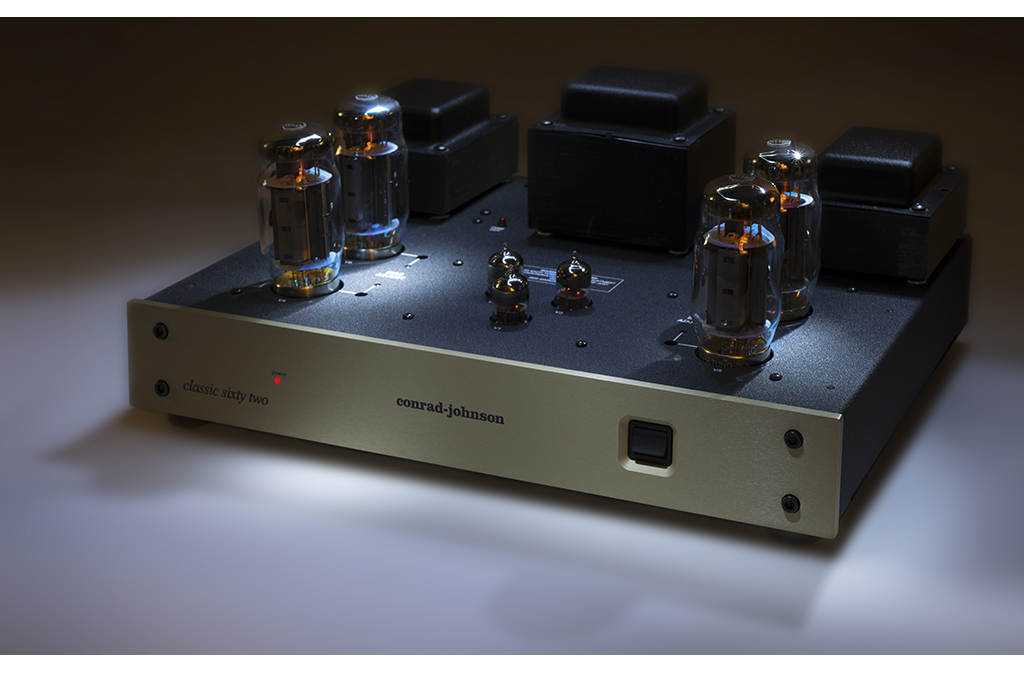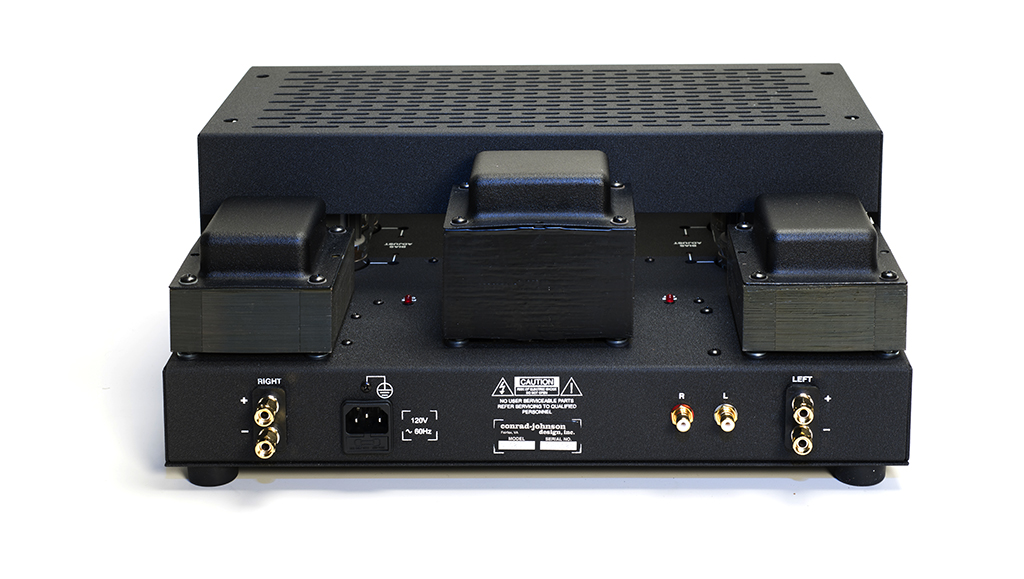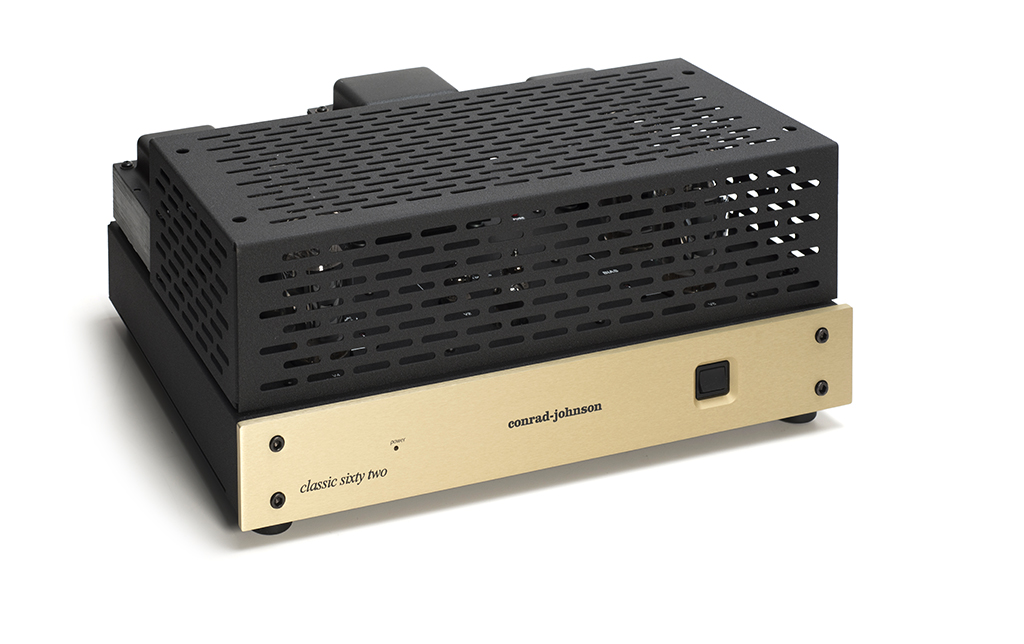REVIEW: Conrad-Johnson Classic 62SE Power Amplifier A Golden Child
By Rob Johnson Bill Conrad and Lew Johnson have worked together for over 40 years, consistently producing products which represent a high level of sonic performance for the dollar.
Bill Conrad and Lew Johnson have worked together for over 40 years, consistently producing products which represent a high level of sonic performance for the dollar.
At the same time, they’ve pushed the boundaries in tube audio design, investing countless hours of engineering experiments, testing, and tweaking before releasing new components. Their amplifiers and preamplifiers have won numerous awards over the years and the company has a very loyal following.
TONEAudio has reviewed many C-J amps over the years, including both of their recent solid-state designs, the MF2275SE and the MF2550SE; fantastic amplifiers in their own right. Our publisher has owned numerous C-J products and makes no bones about being a fan of the marque. Among their latest tube amplifier iterations is the Classic Sixty Two Special Edition (CL62SE), an evolution of the previous Classic Sixty SE (CL60SE) released nearly a decade ago. And like the CL60, there is a standard and SE version, with the latter featuring upgraded components and in particular a full compliment of CJD Teflon capacitors in critical circuit areas.
The Classic series is aimed solidly at those wanting to experience the magic of vacuum tubes at a more accessible price point than their top of the line ART components. While C-J considers the Classic line entry level, for me it reflects an important benchmark for great sonics. Still rated at 60 watts per channel as the CL60, lessons learned from the ART power amplifiers have trickled down to the Classic series.
Rated at 60 watts per channel as the name implies, the CL62SE reviewed here represents an evolution of the circuitry found in its older brother the CL60SE. Despite the numerical designation, I dare say it is more than two better. Conrad-Johnson went through the amp design with a fine-toothed comb, seeking out anything which could benefit from an upgrade. Some trickle-down technology from their latest flagship ART amplifier encouraged a few key differences in the new CL62SE. Among other changes like the use of metal foil resistors, the tube complement shifted slightly. The CL60SE utilizes four KT120 output tubes, along with a pair of 6922 variants, and a single 6189. In the newer CL62SE design, the 6189 is replaced with another 6922.
Appearance
As with many C-J products, the amp retains the classic gold color and a humble, boxy form factor. The hefty transformers rise from the rear of the base, with the tubes residing up front. A vented, black powder coated cage surrounds the tubes to avoid inadvertent skin contact. Those tubes get hot indeed! However, if you do not have children or pets who may be drawn to the tantalizing tubes while you are not there to supervise, it is fun to remove the cage and watch the subtle glow unobstructed. The CL62SE front offers a toggle switch for power, and a small red LED to indicate power up. It is rather apropos, though, since something called the Classic Sixty Two should take on a classic, minimalist form factor, right?
Similar to the front-facing appearance of the amp, the rear panel layout remains equally spartan. Two single-ended inputs accept the connection from a preamp, and a single pair of metal 5-way binding posts get a tight grip on speaker cables. As a tube amp, there is no “standby” power mode as seen in many solid-state designs. Controlled by the switch on the front, the 62 is either on or off. Saving tube life is a good thing, however. With power applied, the amp needs about 30 minutes of warm-up time to sound its best. If you listen to morning music like I do, make the amp your first stop after getting out of bed. Two cups of coffee later, you are ready to rock.
Setup and tube bias
Unlike a solid-state amp prepared for use right out of the box, the CL62SE takes a bit of extra setup due to the tube complement. First off, you will need a long, standard screwdriver to remove the protective grille and gain access to the tube sockets. With the cage removed, the second order of business is unpacking all the valves and loading them firmly into the correct sockets.
The final step is biasing the tubes using the included plastic screwdriver. Biasing serves two purposes: First, it ensures the tubes are adjusted to deliver equal power into the left and right channels. Secondly, it helps increase the life of the tubesby setting them at the point where they are accomplishing their role in kicking all the needed electrons to the internalplates, but not going beyond that required call of duty. Each tube has a finite number of electrons to move, so conserving the stream encourages valve longevity. According to the CL62SE manual, a tube complement should last at least two years if used as directed, but as the saying goes, “your mileage may vary”. Often the tubes last longer, especially when the owner takes care to shut down the amp when not in use.
C-J makes the biasing process surprisingly simple. After power up, four small red LEDs next to the four KT120s indicate each valve’s bias status. If the light is on, the biasing screw next to it needs to be twisted counter-clockwise a bit – just barely enough to turn off the LED. Conversely, if the LED next to each tube is off already, an owner will want to double-check them. Twist the biasing screw clockwise until the LED turns on, then reverse direction very slowly until the LED turns off. C-J recommends this process be repeated after about 30 minutes of use, and maybe every six months after that. Down the road, when new valves join the amp, the process must be completed again. C-J notes that after biasing is complete, LEDs may flicker just a bit when the amp is in heavy use driving speakers. I did not notice that during my time with the CL62SE, but don’t worry if you encounter it.
 After the 62’s requisite warm-up period, with volume all the way down, I put an ear to each speaker to get a sense of background noise and tube hiss. As it turns out, it is hard to distinguish any. One can hear the pings and ticks of the tubesduring warm up, but after that process, the C-J is nearly silent – even more so than most solid-state designs I have experienced.
After the 62’s requisite warm-up period, with volume all the way down, I put an ear to each speaker to get a sense of background noise and tube hiss. As it turns out, it is hard to distinguish any. One can hear the pings and ticks of the tubesduring warm up, but after that process, the C-J is nearly silent – even more so than most solid-state designs I have experienced.
Listening
Admittedly, I have never owned a tube amp and always appreciated the simple nature and bass heft of a great solid-state amp coupled with a tube preamp. Unfortunately for my wallet, I may now be a convert.
Listening to music interpreted by the CL62SE, there are two characteristics which stand out immediately. First, the soundstage of this amp not only extends to the far left and right of the speakers. It also widens well above and behind the speakers – and accomplishes a trick I have heard with few amps – extends the sound stage well in front of the speakers toward the listening seat.
The CL62SE regularly pushed musical elements so far to the left and right of the soundstage, my ears perked from the unexpected, but very welcome, experience. Yes, there are plenty of amps out there that have a wide soundstage, but this C-J generated one of the most expansive and immersive ones experienced in my listening space.
The second surprise in sonics is the way the 62 portrays instruments and vocals. There is not only a very transparent and organic ease to the music, each musical element is exceptionally well defined, even in a very crowded soundstage which overlaps instruments and vocals. Indeed, vocal performances have a level of detail and palpability making them eerily real. Ambient cues, “air”, and sparkle around various musical instruments compounds the miraculous illusion, floating around the room with ease and grace. I had not expected the magnitude of these characteristics and found myself listening for hours to favorite albums. Sometimes, the subtleties make all the difference.
Despite the extreme level of detail, revelation, and a very energetic presentation, there is no stridency to the sound. Soprano vocals, horns, cymbals and other musical elements can have the potential to spark the eardrums. The C-J pours forth all the detail, but without nasty artifacts that sometimes accompany it. This beguiling nature will glue you to the listening seat longer than you might realize.
My concerns about limited, mushy bass quelled quickly as well. The 62 offers quite a bit of muscle despite its modest power rating. Deep bass notes rendered with taught accuracy pour out in a very natural way. Solid state amps can truly excel in the delivery of tight, weighty, and low bass reproduction. Moreover, there is something highly satisfying about punchy bass when one just wants to rock! After re-adjusting my ears to the tubed 62, I did not miss it though. Forget ideas of old-school tube designs with mushy bass and overly-romanticized sound. The 62SE is proof to the contrary. Those listeners who enjoy power over nuance may still prefer a solid-state design, but they are likely to be surprised at what the CL62SE is capable. Despite the “Classic” name, this tube amp is a clear result of modern engineering.
Conclusions
If it is not apparent by now, let me say it plainly. The Classic Sixty Two SE is a stellar amp. Conrad-Johnson’s “entry level” tube amp represents a pinnacle of value at its $5,750 MSRP. If you need more power, C-J offers the CL120SE monoblock version. For those with a tight budget, the standard version of the CL62 sells for $4,250, offering much of the SE sonic prowess.
If this amplifier investment is within your budget, those audio fans who love tube gear – and even those who prefer solid state – should make a point of visiting their local Conrad-Johnson dealer to hear the Classic Sixty Two for themselves. Yes, tube amps do take a little more nurturing over their lifetime, and new valves are needed periodically. C-J offers a full set of replacement tubes for about $500. However, a CL62SE owner will be rewarded in spades for that minimal level of maintenance.
Conrad-Johnson Classic Sixty Two SE Amplifier
MSRP: $ 5,750 (SE version) $4,250 (Standard version)




